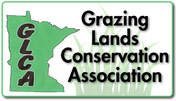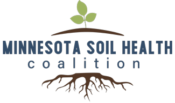Grazing updates
Grazing Lands Conservation Association Announces Gutierrez as new Executive Director
The Minnesota Grazing Lands Conservation Association (GLCA) has hired Mark Gutierrez as the new Minnesota GLCA Executive Director. Gutierrez will be responsible for the management of the GLCA membership and outreach.
“I am excited to bring my experience to the Minnesota Grazing Lands Conservation Association and work with farmers to improve best practices for grazing in Minnesota”, said Gutierrez.
Gutierrez grew up working on a farm and was an active member in Future Farmers of America (FFA) and the National Agri-Marketing Association (NAMA). Gutierrez graduated from New Mexico State University with a M.S. degree in Agricultural Economics and previously worked for the USDA's National Agricultural Statistics Service and as Deputy Director for the RMA crop insurance program. Gutierrez is also Executive Director for the Minnesota Soil Health Coalition.
“We are excited for Mark to work on existing Minnesota GLCA initiatives and advance our association forward,” said Dean Thomas, Minnesota GLCA President. Gutierrez will start in December and can be contacted at [email protected].
The Minnesota Grazing Lands Conservation Association (GLCA) has hired Mark Gutierrez as the new Minnesota GLCA Executive Director. Gutierrez will be responsible for the management of the GLCA membership and outreach.
“I am excited to bring my experience to the Minnesota Grazing Lands Conservation Association and work with farmers to improve best practices for grazing in Minnesota”, said Gutierrez.
Gutierrez grew up working on a farm and was an active member in Future Farmers of America (FFA) and the National Agri-Marketing Association (NAMA). Gutierrez graduated from New Mexico State University with a M.S. degree in Agricultural Economics and previously worked for the USDA's National Agricultural Statistics Service and as Deputy Director for the RMA crop insurance program. Gutierrez is also Executive Director for the Minnesota Soil Health Coalition.
“We are excited for Mark to work on existing Minnesota GLCA initiatives and advance our association forward,” said Dean Thomas, Minnesota GLCA President. Gutierrez will start in December and can be contacted at [email protected].
CRP Haying and Grazing
Haying and grazing of CRP acres is authorized under certain conditions to improve the quality and performance of the CRP cover or to provide emergency relief to livestock producers due to certain natural disasters. There are two types of haying and grazing authorization: non-emergency and emergency.
Emergency haying and grazing of CRP acres may be authorized within a county to provide relief to livestock producers in areas affected by a severe drought or similar natural disaster. Emergency haying and grazing status is reviewed and authorized each Thursday using the U.S. Drought monitor. Counties are approved for emergency haying and grazing due to drought conditions on a county by county basis, when a county is designated as level “D2 Drought - Severe” according to the U.S. Drought Monitor.
In general, non-emergency haying may be utilized every three years and non-emergency grazing may be utilized every two years. Additional grazing may be available to new and beginning farmers.
CRP participants requesting emergency or non-emergency haying and grazing must file a request with their county FSA office indicating the acres to be hayed or grazed before the activity begins.
Before CRP acres are declared eligible for haying or grazing, a modified conservation plan developed by NRCS or a technical service provider must be obtained. The modified conservation plan must be site specific, include the authorized duration and reflect local wildlife needs and concerns. The primary purpose must be to maintain vegetative cover, minimize soil erosion and protect water quality and wildlife habitat quality. These plans must ensure no long-term damage to the conservation cover is caused.
Emergency haying and grazing is authorized on all practices outside the primary nesting season including practices implemented under State Acres for Wildlife Enhancement (SAFE) such as CP38E SAFE-Grass when such activity is specifically outlined in the SAFE agreement. Contact your local office for State Specific restrictions related to SAFE. For non-emergency haying and grazing, all practices are eligible except for CP12 Wildlife Food Plot and several tree practices. Contact your FSA office for a full list of ineligible practices.
Acres ineligible for both emergency and non-emergency haying and grazing include acres devoted to:
------------------------------------------------------------------------------------------------------------------------------------------------------------
USDA - NRCS Minnesota offering pilot Environmental Quality Incentives Program
Contact:
Molly Voeller
Saint Paul, Minn. – June 25, 2021 – Farmers, ranchers, and forest landowners in 13 select counties and federally recognized tribes can apply for conservation practices through the climate smart agricultural and forestry pilot of the Environmental Quality Incentives Program (EQIP). USDA−Natural Resources Conservation Service Minnesota State Conservationist, Troy Daniell, announced the deadline to apply is Friday, July 9, 2021. Applications are being taken at USDA Service Centers in Minnesota. This assistance will help agricultural producers plan and implement voluntary conservation practices that sequester carbon, reduce greenhouse gas emissions and mitigate the impacts of climate change on working lands.
EQIP is the primary program available to farmers and landowners for farm, ranch, and woodland conservation work, usually offering more than 100 conservation practices. “In this pilot, a select group of conservation practices are available in order to support climate smart ag and forestry management systems,” said Daniell. Climate-smart conservation practices will be prioritized in this targeted EQIP for:
• Building soil health.
• Improving nitrogen management.
• Enhancing grazing and pasture management.
• Improving agroforestry, forestry and upland wildlife habitat.
The focus in this pilot will be Federally recognized Tribes throughout Minnesota and producers with land in the following counties: Norman, Mahnomen, East Polk. West Polk, Red Lake, Pennington, Redwood Falls, Brown, Renville, Cottonwood, Watonwan, Martin, and Jackson. Cropland activities will be the emphasis in the listed counties.
Landowners interested in applying for EQIP funding should contact their local NRCS office at the USDA Service Center their county. For more information, visit www.mn.nrcs.usda.gov.
Haying and grazing of CRP acres is authorized under certain conditions to improve the quality and performance of the CRP cover or to provide emergency relief to livestock producers due to certain natural disasters. There are two types of haying and grazing authorization: non-emergency and emergency.
Emergency haying and grazing of CRP acres may be authorized within a county to provide relief to livestock producers in areas affected by a severe drought or similar natural disaster. Emergency haying and grazing status is reviewed and authorized each Thursday using the U.S. Drought monitor. Counties are approved for emergency haying and grazing due to drought conditions on a county by county basis, when a county is designated as level “D2 Drought - Severe” according to the U.S. Drought Monitor.
In general, non-emergency haying may be utilized every three years and non-emergency grazing may be utilized every two years. Additional grazing may be available to new and beginning farmers.
CRP participants requesting emergency or non-emergency haying and grazing must file a request with their county FSA office indicating the acres to be hayed or grazed before the activity begins.
Before CRP acres are declared eligible for haying or grazing, a modified conservation plan developed by NRCS or a technical service provider must be obtained. The modified conservation plan must be site specific, include the authorized duration and reflect local wildlife needs and concerns. The primary purpose must be to maintain vegetative cover, minimize soil erosion and protect water quality and wildlife habitat quality. These plans must ensure no long-term damage to the conservation cover is caused.
Emergency haying and grazing is authorized on all practices outside the primary nesting season including practices implemented under State Acres for Wildlife Enhancement (SAFE) such as CP38E SAFE-Grass when such activity is specifically outlined in the SAFE agreement. Contact your local office for State Specific restrictions related to SAFE. For non-emergency haying and grazing, all practices are eligible except for CP12 Wildlife Food Plot and several tree practices. Contact your FSA office for a full list of ineligible practices.
Acres ineligible for both emergency and non-emergency haying and grazing include acres devoted to:
- Useful life easements;
- Land within 20 feet of a stream or other permanent water body; and
- Any acres where haying and or grazing would cause long-term damage to the CRP cover.
------------------------------------------------------------------------------------------------------------------------------------------------------------
USDA - NRCS Minnesota offering pilot Environmental Quality Incentives Program
Contact:
Molly Voeller
Saint Paul, Minn. – June 25, 2021 – Farmers, ranchers, and forest landowners in 13 select counties and federally recognized tribes can apply for conservation practices through the climate smart agricultural and forestry pilot of the Environmental Quality Incentives Program (EQIP). USDA−Natural Resources Conservation Service Minnesota State Conservationist, Troy Daniell, announced the deadline to apply is Friday, July 9, 2021. Applications are being taken at USDA Service Centers in Minnesota. This assistance will help agricultural producers plan and implement voluntary conservation practices that sequester carbon, reduce greenhouse gas emissions and mitigate the impacts of climate change on working lands.
EQIP is the primary program available to farmers and landowners for farm, ranch, and woodland conservation work, usually offering more than 100 conservation practices. “In this pilot, a select group of conservation practices are available in order to support climate smart ag and forestry management systems,” said Daniell. Climate-smart conservation practices will be prioritized in this targeted EQIP for:
• Building soil health.
• Improving nitrogen management.
• Enhancing grazing and pasture management.
• Improving agroforestry, forestry and upland wildlife habitat.
The focus in this pilot will be Federally recognized Tribes throughout Minnesota and producers with land in the following counties: Norman, Mahnomen, East Polk. West Polk, Red Lake, Pennington, Redwood Falls, Brown, Renville, Cottonwood, Watonwan, Martin, and Jackson. Cropland activities will be the emphasis in the listed counties.
Landowners interested in applying for EQIP funding should contact their local NRCS office at the USDA Service Center their county. For more information, visit www.mn.nrcs.usda.gov.




